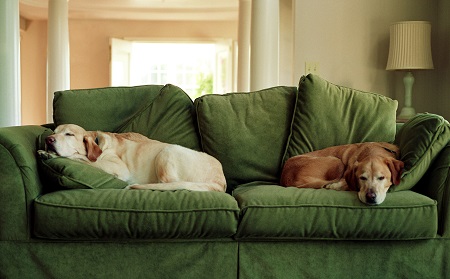Why You Should Spay or Neuter Your Pet

As a vet in practice, I am often asked why people should bother to get their pets spayed and neutered. Why not just leave them to be natural? After all, we don’t spay or neuter humans?
There are two broad reasons and they are both worth explaining in detail.
Population Control
The first reason for spaying and neutering is for population control. If dogs are not neutered or spayed they are likely to breed and, historically, Ireland has a serious problem with unwanted puppies and kittens. Local authority dog pounds in Ireland kill around forty dogs every week. While it is true that some dogs in the pounds may need to be put down because of poor health or dangerous behaviour, it has been estimated that most of the dogs that are euthanased in Irish dog pounds could live long and happy lives if they were given a chance. The truth is that far too many puppies are born in Ireland, and there are not enough homes for them all. In an effort to deal with this problem, as well as promoting spaying and neutering, animal rescue groups now export thousands of unwanted dogs every year to the UK and other countries. It is still not enough. There are still too many dogs here.
If owners took a more responsible approach to their dogs’ reproductive lives, more dogs would be spayed and neutered, less puppies would be born, and fewer dogs would end up being killed in Ireland’s dog pounds. One study showed that around 50% of dog litters born in Ireland are unplanned: if these unplanned pregnancies were prevented by spaying and neutering, the overpopulation problem would be solved.
The situation is no better for cats, with countless unwanted adults and kittens being euthanased every year. Nobody keeps records of how many die: there is no such thing as a “cat pound”, and the euthanasias happen quietly behind the scenes at vet clinics, or new born kittens are drowned in buckets with nobody watching. But there is no doubt that, as with dogs, unplanned breeding leads to the deaths of many thousands of cats. Again, as with dogs, the simple answer is to have all cats routinely spayed and neutered: this would reduce the suffering of many kittens and cats who would be spared the experience of living short, unwanted lives before being killed.
Health Benefits
The second reason why people should have their pets spayed and neutered is to improve the health of the individual animal. For each type of animal, there is a different rationale behind this.
Female Dogs

Spaying a female dog eliminates the risk of unwanted pregnancy, dystocia (difficulty whelping) and prevents the physical and behavioural changes associated with the six-monthly reproductive cycle. It also dramatically reduces the risk of mammary cancer and removes the risk of pyometra (an infected womb) which occurs in 23% of intact females and kills approximately 1% of intact females.
Mammary tumours are the most common malignant tumours in female dogs, and spaying before 2.5 years of age greatly reduces the likelihood of this cancer. Spaying also eliminates the risk of uterine, cervical and ovarian tumours, as well as reducing the risk of perianal fistulas, a common problem in some breeds.
Female Cats
Entire cats are seven times more likely to develop mammary cancer than those spayed at puberty. Mammary growths are the third most common form of tumour in cats and 80% of feline mammary tumours are malignant.
Spaying prevents unwanted pregnancies/litters, eliminates the risk of dystocia (difficulty birthing kittens) and removes the risk of pyometra (an infected womb).
Apart from preventing the agitated behaviour of a female cat in season, spaying eliminates or reduces a number of other undesirable feline behaviours.
Male Dogs
Castration prevents testicular cancer, the second most prevalent cancer among male dogs. Castration dramatically reduces the incidence of other non-cancerous conditions of the mature prostate (e.g. benign prostatic hyperplasia, prostatitis/prostatic abscesses, prostatic cysts and para-prostatic cysts). Without castration, prostatic hyperplasia (increased size of the prostate gland) starts at 1-2 years of age with 95% of dogs affected by 9 years of age.
Castration dramatically reduces the risk of tumours of the perineum, such as perianal adenoma and perianal fistulas.
Castration also affects dog behaviour, reducing aggression and dominance in male dogs. It can reduce sibling rivalry, lessen territorial marking with urine, reduce the likelihood of roaming/straying, and lessen the incidence of embarrassing behaviours like dry humping cushions, owners legs etc.
Male Cats

Neutering reduces fighting and territorial behaviour by over 80%, significantly reducing the injuries that result from these behaviours, such as cat bite abscesses. This reduction in fighting also reduces the risk of FIV and Feline Leukaemia viral infection.
Neutering also significantly reduces male urine marking behaviour.
Is there any evidence of any adverse effects of spaying or neutering in dogs?
While it is true that castration has been shown to lead to an increased risk of bladder and prostate cancer, the incidence of these cancers is very low compared with testicular cancer and other prostatic diseases in entire dogs.
Spayed and neutered animals are more likely to become overweight and obese, because reductions in sex hormone levels after neutering slow down the metabolism. However obesity is easily prevented by careful attention to diet and exercise, and there are many lean neutered animals, as well as plenty of obese non-neutered pets.
There is some recent evidence that spaying and neutering before skeletal maturity increases the risk of bone tumours (osteosarcoma) in large and giant breeds of dog. For this reason, it is now recommended that these larger breeds should not be neutered or spayed until they are skeletally mature (e.g. 18 months of age), whereas smaller breeds should still be neutered or spayed when younger (from 6 -7 months of age). Pet owners should have a discussion with their own vet about the precise timing of spaying/ neutering, because the recommendation does vary from animal to animal.
Urinary incontinence is more likely to occur in bitches that are spayed at any age (4-20%) compared with bitches that are not spayed (0.3%). This can occur soon after spaying or after a delay of several years. However, most cases respond well to simple treatment, and most people agree that the risk of this problem is much less serious than the alternative risk of malignant mammary cancer. There is still debate over whether spaying before the first season marginally increases or decreases the risk of this urinary incontinence.
Some studies have made tentative links between spaying/ neutering and cardiac haemangio-sarcoma, hypothyroidism, progressive geriatric impairment, urinary tract cancers, orthopaedic disorders, adverse vaccine reactions, splenic haemangio-sarcoma, recurring urinary tract infections, urinary tract tumours, recessed vulva, vaginal dermatitis and vaginitis if spayed before puberty. However, the evidence for causal connections like this is weak compared to the proven positive effects.
With improved computerisation and connectivity of vets, it is likely that more data will be generated on these topics in future years, so if anyone has particular concerns, they should discuss these with their vets.
Conclusion
For most pets, spaying or neutering in the first two years of life is the best answer, most likely to lead to a long, healthy life for the animals and a hassle free life for their owners. As with many aspects of pet care, it is important to discuss this topic with your own vet, who knows your particular animal, so that the right decision and the best time to do the operation can be decided.





